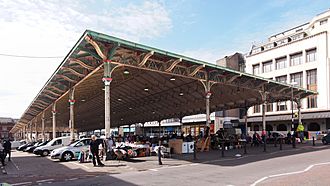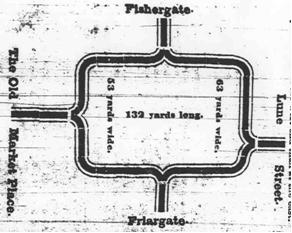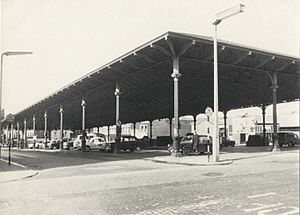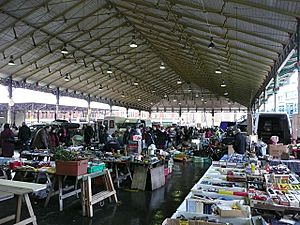Covered Market, Preston facts for kids
Quick facts for kids Covered Market |
|
|---|---|

The Covered Market in 2015
|
|
| General information | |
| Town or city | Preston, Lancashire |
| Country | England |
| Coordinates | 53°45′38″N 2°41′58″W / 53.7605°N 2.6995°W |
| Construction started | 1870 |
| Completed | 1875 |
| Design and construction | |
| Architect | Edward Garlick |
| Main contractor | William Allsup |
| Designations | |
|
Listed Building – Grade II
|
|
| Designated: | 27 September 1979 |
| Reference #: | 1218479 |
The Covered Market in Preston, England, is a really old and important building. It was built between 1870 and 1875. This market is so special that it's officially protected as a Grade II listed building.
It took a long time to build this market. There were three tries to start the project in the early 1800s. Then, a serious accident happened during construction in 1870. But finally, the market was finished in 1875. Since then, new parts have been added, and it has been updated many times.
Contents
What makes the Preston Covered Market special?
The Covered Market was built with strong cast iron pillars. It has a cool roof made of iron, wood, and glass. The roof is super wide, about 90 feet across, with no pillars in the middle. This means there's lots of open space inside!
One of the most interesting things about the market is how it handles rainwater. Water from the roof is collected in a hidden gutter. Then, it flows down the inside of the hollow pillars. It's a clever way to keep the market dry!
Why was a covered market needed?
People in Preston wanted a covered market for a long time. Back in 1837, the town leaders started thinking about it. They even moved the fish market to a covered spot. But they kept running out of money, so the plans were stopped many times.
In 1846, a local newspaper suggested using an existing building for the market. But nothing happened. Again, in 1848, the town tried to get money from the government for a new market. They wanted about £40,000. But once more, the project was put on hold because of money problems.
Even in the early 1850s, new plans were made, but they were also set aside. It seemed like the covered market would never get built!
How did the market finally get started?
Finally, in 1860, work on the Preston Covered Market truly began. The town leaders created a special committee for the market. They also got money through new laws passed in 1861 and 1869.
The town centre of Preston was very crowded back then. People wanted "complete and broad approaches" to the new market. This would help open up the area.
Edward Garlick, who was the town's surveyor, visited many other markets. He then suggested a plan for Preston's market. The town council liked his idea and put the project up for bids in 1870. Ten companies offered to build it. Joseph Clayton, who owned a foundry (a place where metal is cast), offered the lowest price at £6,070. He promised to finish the market by July 31, 1870.
The big construction accident
Building the market didn't go smoothly. Joseph Clayton was slow to start. He said he needed to make all the metal parts first. In April 1870, the first pillars were put up. But he missed the deadline. The town council started to get upset.
Then, on August 6, 1870, something terrible happened. Ten workers were on the site. Suddenly, a huge part of the roof that had been built collapsed! It fell with a "tremendous crash." Nine workers managed to escape without getting hurt. But one worker, Thomas Bateson, was seriously injured. Luckily, he recovered later.
Pictures from that time show the market completely broken. Most of the pillars had been put up, so the basic structure was almost done. It was a huge setback.
New builders step in
After the accident, the council hired a new company, P B Bennett and Co, in 1871. They were supposed to finish the market for £9,000. But Bennett never started. They said the design was unsafe. The council disagreed, and no work was done.
In November 1871, the council gave the job to William Allsup of Preston. But Bennett didn't leave the site until April 1872. Finally, in May 1872, Allsup could start work. His cost was £9,126.
William Allsup finally finished building the Preston Covered Market in November 1875. It took much longer than planned, but it was finally done!
The market today
Over the years, the market has changed. In 1924, the old fish market area was covered. In 1958, big changes were made to the main market. The glass skylights were removed, electric lights were put in, and the old stone floor was replaced.
In the 1970s, a new market hall was built next to the covered market. More recently, in the 2010s, there were plans to build a cinema and restaurants where the 1970s building stood. A new market hall would be built under the old covered market roof. These plans were approved in 2016. The market was updated in 2017, and the new market hall opened in 2018.
In September 2021, a cool bronze statue of Wallace & Gromit was put up at the market entrance. Wallace is wearing his "Wrong Trousers," and Gromit is reading a newspaper. This statue honors Nick Park, who created Wallace & Gromit and is from Preston!




